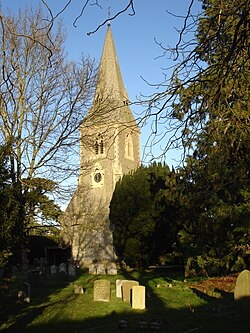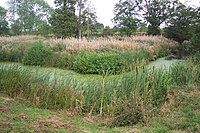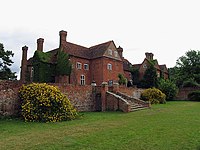Ufton Nervet
| Ufton Nervet | |
| Berkshire | |
|---|---|
 St Peter's parish church | |
| Location | |
| Grid reference: | SU6367 |
| Location: | 51°24’11"N, 1°5’17"W |
| Data | |
| Population: | 296 (2011) |
| Post town: | Reading |
| Postcode: | RG7 |
| Dialling code: | 0118 |
| Local Government | |
| Council: | West Berkshire |
| Parliamentary constituency: |
Wokingham |
| Website: | Sulhamstead and Ufton Nervet |
Ufton Nervet is a village in Berkshire, six miles west of Reading.
The name "Ufton" is from the Old English Uffantun meaning 'Uffa's farmstead' and the Domesday Book of 1086 records it as Offetune.[1] "Nervet" is from manorial ownership in the Middle Ages: Richard Neyrvut held the manor in the 13th century.
The lie of the land
Ufton Nervet is a strip parish about 4½ miles long and up to a miles wide, running roughly north-northwest – south-southeast between the Kennet valley and the crest of low hills in its south. It is bounded to the north by the A4 road, to the south by a minor road linking Burghfield and Tadley, and to the west and east by a mixture of field boundaries and minor roads. It includes a section of the River Kennet, the Kennet Navigation and the railway between Reading and Taunton.
Ufton Nervet village is a clustered one close to the parish's eastern boundary, less than a mile from Burghfield Common and Sulhamstead. Two minor roads link the village with the A4, crossing the canal and the railway line in the valley bottom. Both lanes cross the canal by swing bridges. The smaller passes through Ufton Green and crosses the railway by a level crossing. The larger passes through part of Sulhampstead and crosses the railway by a bridge. Other lanes link the village with Burghfield Common, Sulhamstead Abbots and Stratfield Mortimer. Its direct link with Padworth to the west is a footpath past Ufton Court; the only road links with Padworth are circuitous ones via the southern or northern edges of the parish.
Archaeology
Excavation of a site at Ufton Green found a number of scattered Mesolithic stone artefacts. They are interpreted as evidence of stone-working to make tools or weapons.[2]
Manor


Three manors have existed in this area: Ufton Robert, Ufton Nervet and Ufton Pole.[3] The Domesday Book records the first two.[3]
The original Ufton Nervet, also called Ufton Richard, was about half a mile northwest of the current village, at the current site of Ufton Green.[3] It had its own parish church of St John the Baptist, the ruined west wall of which survives[3][4] and is a scheduled monument.[5].[3]
Ufton Robert manor house was just west of the current village. Its moat and a set of three mediæval fishponds survive and are also a scheduled monument.[6] An artificial stream, controlled by a set of sluices, fed the moat and ponds.[7] Excavations in the 19th century found bridge piles, a gateway and other foundations.
The Perkyns family held the manor from about 1411.[3] When they bought the manor of Ufton Pole in 1560 they merged the two manors and moved the main residence to Ufton Pole. This is now Ufton Court, a large Elizabethan manor house about half a mile southwest of the village.[3] The house was built in about 1568, altered in the 17th and 18th centuries, restored in 1838 and is now a Grade I listed building.[8]
In 1434–35 the parishes of Ufton Nervet and Ufton Robert were merged and Ufton Robert's parish church of St Peter was made the church of the merged parish.[3] Although the original parish of Ufton Nervet had ceased to exist, this eventually became the name of the current village and parish.[3] After the merger, Ufton Robert's parish church of St John the Baptist fell into decay, but its west wall survived by being adopted as the dividing wall between two cottages. In 1886 the cottages were demolished, re-exposing the west wall[3] which now stands isolated in a pasture.
Parish church
The parish church is St Peter. It was built in 1862 on the site of an earlier church.[3] It is a Gothic Revival rendition of 14th-century Decorated Gothic.[4] The walls are predominantly rag-stone with ashlar dressings. It has a chancel, north chapel (used as an organ chamber), nave of three bays, west tower with tall octagonal shingled spire, and south porch.[9]
The present St Peter's contains church monuments salvaged from the old church.
The church today is redundant and the village is part of the parish of 'Sulhamstead Abbots and Bannister with Ufton Nervet'.
Economic history
The River Kennet flows through the north of the parish. Between 1718 and 1723 it was made navigable by digging a series of cuts controlled by locks. One 3-mile cut starts about a mile downstream from Aldermaston and ends at Ufton Bridge, where it was controlled by Ufton Lock. The lock gates have now been removed but the lock chamber survives. Between 1794 and 1810 the Kennet and Avon Canal was built from Newbury to Bath. The Kennet Navigation is now managed as part of the canal.
The Berkshire line of the Berks and Hants Railways from Reading to Hungerford was built through the north of the parish and opened in 1847. The nearest station remains Aldermaston, 3½ miles by road.
Rail crash
The Ufton Nervet crash took place in the parish on 6 November 2004. Seven people were killed and 70 injured when the main service from London Paddington to Plymouth which passes through here was derailed by colliding with a stationary car on the level crossing. Road deaths at the crossing have followed in 2009, 2010, 2012 and 2014.
Outside links
| ("Wikimedia Commons" has material about Ufton Nervet) |
References
- ↑ "Berkshire N–Z". The Domesday Book Online. 1999–2013. http://www.domesdaybook.co.uk/berkshire3.html.
- ↑ National Monuments Record: No. 1213740
- ↑ 3.00 3.01 3.02 3.03 3.04 3.05 3.06 3.07 3.08 3.09 3.10 Page & Ditchfield 1923, pp. 437–444
- ↑ 4.0 4.1 Pevsner 1966, p. 246
- ↑ National Heritage List 1006967: Remains of St John the Baptist church at Ufton Green Farm
- ↑ National Heritage List 1013176: Moated site and three fishponds at Ufton Nervet
- ↑ National Monuments Record: No. 240946
- ↑ National Heritage List 1135879: Ufton Court
- ↑ National Heritage List 1319598: Church of St Peter
- Page, W.H.; Ditchfield, P.H., eds (1923). A History of the County of Berkshire. Victoria County History. 3. assisted by John Hautenville Cope. London: The St Katherine Press. pp. 437–444. http://www.british-history.ac.uk/report.aspx?compid=43241.
- Pevsner, Nikolaus (1966). Berkshire. The Buildings of England. Harmondsworth: Penguin Books. p. 246.
